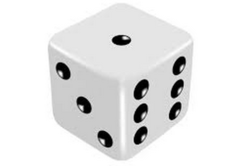Dice Battle
 Amy and Brian take turns rolling a fair, six-sided die, and whomever first rolls a 6 wins. What is the probability that Amy wins if she goes first?
Amy and Brian take turns rolling a fair, six-sided die, and whomever first rolls a 6 wins. What is the probability that Amy wins if she goes first?
Give your answer to 3 decimal places.
The answer is 0.54545.
This section requires Javascript.
You are seeing this because something didn't load right. We suggest you, (a) try
refreshing the page, (b) enabling javascript if it is disabled on your browser and,
finally, (c)
loading the
non-javascript version of this page
. We're sorry about the hassle.
1 solution
Kindly tell if this method is right,ma'm P A = p r o b a b i l i t y t h a t A m y w i n s = 6 1 + 6 5 ( P t h a t A m y d o e s n ′ t r o l l o u t a s i x i n h e r f i r s t t r y ) × 6 5 ( P t h a t B r i a n d o e s n ′ t r o l l o u t a s i x i n h i s f i r s t t r y ) × P A .This also gives the answer as P A = 1 1 6 . @Eli Ross
Log in to reply
@Pi Han Goh is this correct?
Log in to reply
Nope. I don't see how you get 6/11 as the answer. What I did was to write it as a geometric series. That is P(Amy win 1st try) + P(Amy win 3rd try) + P(Amy wins 5th try) + .... = 6/11
Log in to reply
@Pi Han Goh – Take P A = x ,we get, x = 6 1 + 3 6 2 5 x x = 3 6 6 + 2 5 x 3 6 x = 2 5 x + 6 1 1 x = 6 x = 6 / 1 1 .What is wrong with this reasoning?Once Brian rolls out some number other than a 6 we are back to square one and the game starts again and now too the probability that Amy wins is P A . @Pi Han Goh
Log in to reply
@Adarsh Kumar – Oh haha, I did'nt see your last PA at the end. My bad. Correct.
Log in to reply
@Pi Han Goh – Oh,no problem!Thanks a lot brother!Grateful!
I didn't understand why on first turn Brian has the probability of 5/6....why isn't it 1/6 like amy's? ??They are rolling the same die and it's a fair one....does 'amy hasn't got a 6' mean that Brian is more likely to get a 6???
Let P A and P B be the probabilities that Amy and Brian win, respectively. On her first roll, Amy can win (with probability 6 1 ), or it will be Brian's turn (with probability 6 5 ).
However, once it is Brian's turn, it is essentially as if the game has started over and Amy is to go second, so the probability that she wins at this point is the same as the probability that Brian would win the game in the beginning. In other words,
P A = 6 1 + 6 5 ⋅ P B .
Since P A + P B = 1 , we have P A = 6 1 + 6 5 ⋅ ( 1 − P A ) , so P A = 1 1 6 .